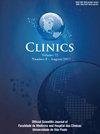Eugenol alleviates renal ischemia-reperfusion injury induced-endoplasmic reticulum stress via activating Sestrin2
IF 2.4
4区 医学
Q2 MEDICINE, GENERAL & INTERNAL
引用次数: 0
Abstract
Introduction
Renal Ischemia-Reperfusion Injury (RIRI) often arises due to heightened oxidative stress, rendering it a central focus of research. Sestrin2 plays a pivotal role in regulating oxidative stress; nevertheless, its impact on the renoprotective properties of Eugenol (EU) during RIRI warrants further investigation.
Methods
Mice and TCMK-1 cells were categorically assigned into six groups: Sham/Control, Ischemia-Reperfusion (IR)/HR (Hypoxia-Reoxygenation), IR/HR+EU, Sham/Control+Sestrin2-KO, IR/HR+Sestrin2-KO, and IR/HR+EU+Sestrin2-KO. The effects of EU and the involvement of Sestrin2 in RIRI/HR were evaluated using Urea Nitrogen (BUN), Creatinine (Scr), Superoxide Dismutase (SOD), Glutathione (GSH), Catalase (CAT), and Malondialdehyde (MDA) assay kits; western blotting; cell viability assays; HE-staining; and Reactive Oxygen Species (ROS) detection.
Results
Following RIRI/HR, a marked deterioration in kidney function and a significant surge in oxidative stress levels were observed. However, EU treatment ameliorated renal injury and inhibited oxidative stress. Additionally, EU upregulated Sestrin2 expression, and the renoprotective effects of EU were reversed upon Sestrin2 knockdown.
Conclusion
The present study posits that EU effectively mitigates RIRI/HRI (Hypoxia-Reoxygenation Injury), and its mechanism of renal protection potentially involves the upregulation of Sestrin2, coupled with the inhibition of oxidative and Endoplasmic Reticulum Stress (ERS).
丁香酚通过激活 Sestrin2 减轻肾缺血再灌注损伤诱导的内质网应激反应
引言 肾缺血再灌注损伤(RIRI)通常是由于氧化应激加剧而引起的,因此成为研究的重点。Sestrin2 在调节氧化应激中起着关键作用;然而,在 RIRI 期间,它对丁香酚(EU)肾保护特性的影响值得进一步研究:方法将小鼠和TCMK-1细胞分为六组:Sham/对照组、缺血再灌注(IR)/HR(缺氧再氧)组、IR/HR+EU组、Sham/对照组+Sestrin2-KO组、IR/HR+Sestrin2-KO组和IR/HR+EU+Sestrin2-KO组。使用尿素氮 (BUN)、肌酸酐 (Scr)、超氧化物歧化酶 (SOD)、谷胱甘肽 (GSH)、过氧化氢酶 (CAT) 和丙二醛 (MDA) 检测试剂盒、Western 印迹、细胞活力检测、HE 染色和活性氧 (ROS) 检测评估了 EU 的影响和 Sestrin2 在 RIRI/HR 中的参与。结果RIRI/HR后,肾功能明显恶化,氧化应激水平显著升高。然而,EU 治疗可改善肾损伤并抑制氧化应激。结论本研究认为,EU 能有效缓解 RIRI/HRI(缺氧-再氧合损伤),其保护肾脏的机制可能涉及 Sestrin2 的上调以及氧化应激和内质网应激(ERS)的抑制。
本文章由计算机程序翻译,如有差异,请以英文原文为准。
求助全文
约1分钟内获得全文
求助全文
来源期刊

Clinics
医学-医学:内科
CiteScore
4.10
自引率
3.70%
发文量
129
审稿时长
52 days
期刊介绍:
CLINICS is an electronic journal that publishes peer-reviewed articles in continuous flow, of interest to clinicians and researchers in the medical sciences. CLINICS complies with the policies of funding agencies which request or require deposition of the published articles that they fund into publicly available databases. CLINICS supports the position of the International Committee of Medical Journal Editors (ICMJE) on trial registration.
 求助内容:
求助内容: 应助结果提醒方式:
应助结果提醒方式:


